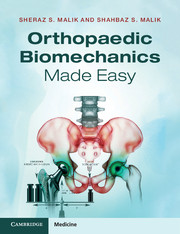Book contents
- Frontmatter
- Dedication
- Contents
- Contributors
- Epigraph
- Preface
- Acknowledgements
- Part I Orthopaedic biomaterials and their properties
- Part II Engineering theory applied to orthopaedics
- Part III Clinical biomechanics
- 6 Biomechanics of the hip and total hip replacement
- 7 Biomechanics of the knee and total knee replacement
- 8 Biomechanics of the shoulder
- 9 Biomechanics of the elbow
- 10 Biomechanics of the spine
- 11 Biomechanics of the ankle and foot
- 12 Biomechanics of fracture fixation
- 13 Trauma meeting: case-based discussions
- Index
- References
13 - Trauma meeting: case-based discussions
from Part III - Clinical biomechanics
Published online by Cambridge University Press: 05 June 2015
- Frontmatter
- Dedication
- Contents
- Contributors
- Epigraph
- Preface
- Acknowledgements
- Part I Orthopaedic biomaterials and their properties
- Part II Engineering theory applied to orthopaedics
- Part III Clinical biomechanics
- 6 Biomechanics of the hip and total hip replacement
- 7 Biomechanics of the knee and total knee replacement
- 8 Biomechanics of the shoulder
- 9 Biomechanics of the elbow
- 10 Biomechanics of the spine
- 11 Biomechanics of the ankle and foot
- 12 Biomechanics of fracture fixation
- 13 Trauma meeting: case-based discussions
- Index
- References
Summary
Mechanics of trauma meeting
The trauma meeting is an integral part of orthopaedic practice. It focuses on the clinical application of biomechanics in the context of the trauma patient. There is no ‘one size fits all’ approach to fracture management, but biomechanical principles apply whichever treatment modality is used.
The management of a trauma patient depends on a number of factors:
patient factors, e.g. co-morbidities, lifestyle and functional demands
the nature of the injury, e.g. the fracture pattern, soft tissue involvement, neurovascular status and other associated injuries
surgical factors, e.g. local expertise and surgeon's preference of treatment.
It is therefore often said in orthopaedics that the management of a fracture depends on the ‘personality’ of the patient, ‘personality’ of the fracture and ‘personality’ of the surgeon.
The aim of this chapter is to highlight biomechanical aspects of different treatment modalities in relation to specific fractures. It is not intended to focus on fracture classifications, on surgical technique or to provide an extensive clinical review of the outcome of treatments. Instead, the chapter focuses on biomechanical interactions between specific fractures and fixation techniques. It therefore illustrates the approach to comparing and contrasting different techniques used in the management of a family of fractures. In order to keep the discussions simple and manageable, key characteristics of implants and general trends in management are presented, and the finer points and controversies have been left out intentionally.
- Type
- Chapter
- Information
- Orthopaedic Biomechanics Made Easy , pp. 186 - 206Publisher: Cambridge University PressPrint publication year: 2015

